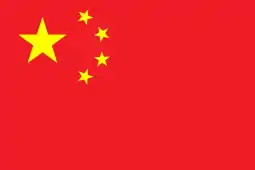Soong Ching-ling
Rosamond Soong Ching-ling (27 January 1893 – 29 May 1981) was a Chinese political figure. As the third wife of Sun Yat-sen, one of the leaders of the 1911 revolution that established the Republic of China, she was often referred to as Madame Sun Yat-sen. She was a member of the Soong family and, together with her siblings, played a prominent role in China's politics prior to and after 1949.
Rosamond Soong Ching-ling | |
|---|---|
宋庆龄 | |
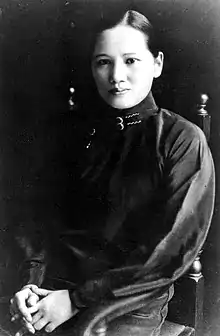 | |
| Honorary President of the People's Republic of China | |
| Appointed by | the Standing Committee of the 5th National People's Congress on 16 May 1981 |
| Premier | Zhao Ziyang |
| Leader | Deng Xiaoping and Chen Yun |
| 2nd Vice Chairperson of the People's Republic of China | |
| In office 27 April 1959 – 17 January 1975 Served alongside Dong Biwu during the 2nd and 3rd National People's Congresses | |
| President | Liu Shaoqi vacant (1968–1972) Dong Biwu (Acting) |
| Preceded by | Zhu De |
| Succeeded by | Ulanhu (1983) |
| Chairwomen of the People's Republic of China | |
| In office 31 October 1968 – 24 February 1972 Co-acting alongside Dong Biwu as Vice Chairpersons of the People's Republic of China during the 3rd National People's Congress | |
| Premier | Zhou Enlai |
| Leader | Mao Zedong |
| Preceded by | Liu Shaoqi (as Chairman) |
| Succeeded by | Dong Biwu (as Acting Chairman) |
| In office 6 July 1976 – 5 March 1978 As acting Chairwoman of the Standing Committee of the 4th National People's Congress | |
| Premier | Hua Guofeng |
| Leader | Hua Guofeng |
| Preceded by | Zhu De (died in office) |
| Succeeded by | Ye Jianying |
| Vice Chairperson of the Standing Committee of the National People's Congress | |
| In office 17 January 1975 – 29 May 1981 4th and 5th National People's Congresses | |
| Chairman | Zhu De (died in office) Ye Jianying |
| In office 15 September 1954 – 18 April 1959 1st National People's Congress | |
| Chairman | Liu Shaoqi |
| Vice Chairperson of the Central People's Government | |
| In office 1 October 1949 – 27 September 1954 Served alongside Zhu De, Liu Shaoqi, Li Jishen, Zhang Lan, Gao Gang | |
| Chairman | Mao Zedong |
| Preceded by | Government established |
| Succeeded by | Zhu De (as Vice Chairman of the PRC) |
| Personal details | |
| Born | 27 January 1893 Shanghai, Jiangsu, Qing Empire |
| Died | 29 May 1981 (aged 88) Beijing, People's Republic of China |
| Cause of death | Leukemia |
| Political party | Kuomintang (1919–1947) Communist International (1930s–1943) Revolutionary Committee of the Chinese Kuomintang (1948–1981) Communist Party of China (1981) |
| Spouse(s) | Sun Yat-sen (1915–1925) |
| Parents | Charlie Soong and Ni Kwei-tseng |
| Alma mater | Wesleyan College |
| Soong Ching-ling | |||||||||||||||||||
|---|---|---|---|---|---|---|---|---|---|---|---|---|---|---|---|---|---|---|---|
.svg.png.webp) "Soong Ching-ling" in Traditional (top) and Simplified (bottom) Chinese characters | |||||||||||||||||||
| Traditional Chinese | 宋慶齡 | ||||||||||||||||||
| Simplified Chinese | 宋庆龄 | ||||||||||||||||||
| |||||||||||||||||||
After the establishment of the People's Republic of China in 1949, she held several prominent positions in the new government, including Vice Chairman (1949–1954; 1959–1975) and Vice Chairman of the Standing Committee of the National People's Congress (1954–1959; 1975–1981), travelled abroad during the early 1950s, representing her country at a number of international events. During the Cultural Revolution, however, she was heavily criticized.[1] Following the purge of President Liu Shaoqi in 1968, she and Dong Biwu as Vice Presidents became de facto Heads of State of China until 1972,[2] when Dong was appointed Acting President. Soong survived the political turmoil during the Cultural Revolution, but appeared less frequently after 1976. As the acting Chairwoman of the Standing Committee of the National People's Congress from 1976 to 1978, Soong was again the acting Head of State. During her final illness in May 1981, she was given the special title of "Honorary President of the People's Republic of China".
Life and activities before 1949
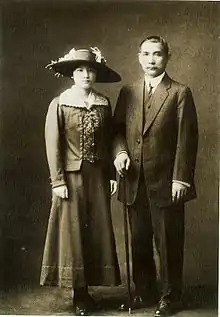
Soong Ching-ling was born to businessman and missionary Charlie Soong in Chuansha, Pudong, Shanghai,[3][4] the second of six children. She graduated from McTyeire School for Girls in Shanghai, and Wesleyan College in Macon, Georgia, United States.[5] Like her sisters, she spoke fluent English due to being educated in English for most of her life. Her Christian name was Rosamonde (in her early years, her passport name was spelt as Chung-ling Soong, and in her Wesleyan College diploma, her name was Rosamonde Chung-ling Soong).
Soong married Sun Yat-sen, leader of China's 1911 revolution and founder of the Kuomintang (KMT or Nationalist Party), on 25 October 1915, even though her parents greatly opposed the match. (Dr. Sun was 26 years her senior.) After Sun's death in 1925, she was elected to the KMT Central Executive Committee. However, she left China for Moscow after the expulsion of the Communists from the KMT in 1927, accusing the KMT of betraying her husband's legacy. Her younger sister, May-ling, married Chiang Kai-shek shortly afterward, making Chiang Soong's brother-in-law.
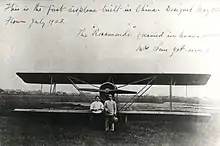
Soong returned to China in June 1929 when Sun Yat-sen was moved from his temporary burial site in Beijing to a new memorial in Nanjing, but left again three months later, and did not return until July 1931, when her mother died. She resided afterwards in Shanghai until July 1937, when the Second Sino-Japanese War broke out. Following the outbreak of hostilities, she moved first to Hong Kong (where she befriended future restaurateur and philanthropist Madame Wu [Sylvia Cheng][6]), then to Chongqing, the wartime capital of the Chinese government. In 1939, she founded the China Defense League, which raised funds and sought supplies primarily for the Chinese Communist controlled areas of northern China. In 1946, the League was renamed the China Welfare fund, continuing to seek funds and support for the Chinese Communists.[7]

During the Chinese Civil War, Soong permanently broke with her family and supported the Communists. In 1948, she became honorary chairwoman of the Revolutionary Committee of the Kuomintang, a left-wing splinter group of the KMT that claimed to be the legitimate heir of Sun's legacy.[8] With the collapse of the Nationalist government and the Communist victory in the civil war, she left Shanghai in September 1949 to attend the Chinese People's Political Consultative Conference (CPPCC), convened in Beijing by the Chinese Communist Party to establish a new Central People's Government. On 1 October, she was a guest at the ceremony in Tiananmen Square marking the birth of the new People's Republic of China. The Nationalist government issued an order for her arrest,[9] but this was soon blocked by the swift military victory of the Communists. The KMT fled from mainland China to Taiwan soon after this.
Political offices and activities after 1949
Soong was held in great esteem by the victorious Communists, who reckoned her as a link between their movement and Sun's earlier movement.[8] After the formal establishment of the People's Republic of China in 1949, she became one of six vice chairpeople of the Central People's Government,"[10] and one of several vice-chairpeople of the Sino-Soviet Friendship Association.[10] In April 1951, it was announced that she had been awarded the Stalin Peace Prize for 1950.[11]
In 1950, Soong became chairwoman of the Chinese People's Relief Administration, which combined several organizations dealing with welfare and relief issues. Her China Welfare Fund was reorganized as the China Welfare Institute and began publishing the magazine China Reconstructs, now published as China Today. In 1953, a collection of her writings, Struggle for New China, was published.[11]
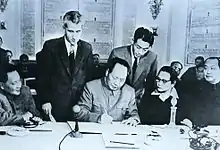
In 1953 Soong served on the committees preparing for elections to the new National People's Congress and the drafting of the 1954 constitution. Soong was elected a Shanghai deputy to the first NPC, which adopted the constitution at its first meeting in September 1954. She was elected one of 14 vice-chairpeople of the NPC's standing committee, chaired by Liu Shaoqi. In December of the same year, she was elected a vice-chairwoman of the CPPCC, which became a consultative body, and replaced Liu Shaoqi as chairperson of the Sino-Soviet Friendship Association. During this period, Soong traveled abroad several times, visiting Austria, India, Burma, Pakistan, and Indonesia. Her trips included a January 1953 visit to the Soviet Union, where she was received by Stalin shortly before his death. She visited Moscow again in 1957 with Mao Zedong's delegation to the 40th anniversary of the Russian Revolution.[11]
Vice-presidency
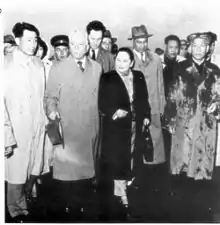
In April 1959, Soong again served as a Shanghai deputy at the 2nd National People's Congress. At this Congress, Mao Zedong and Zhu De stepped down as President and Vice-President of the People's Republic of China. Liu Shaoqi was elected State Chairman (President), and Soong Ching-ling and Dong Biwu, a senior Communist Party 'elder', were elected Vice President of China. Soong resigned at this time from her positions as vice-chairwoman of the CPPCC National Committee and the NPC Standing Committee.[11] She was re-elected to the post of Vice-chairperson of the PRC at the Third National People's Congress in 1965, and appeared frequently in the early 1960s on ceremonial occasions, often greeting important visitors from abroad.
During the Cultural Revolution (1966–76), Soong was heavily criticized by Red Guard factions, and in one incident, the marker of her parents' grave was toppled and their bodies exposed.[1] According to Soong's biographer, following this incident Premier Zhou Enlai recommended that Soong Ching-ling be put on a "List of Cadres to be protected." Zhou's recommendation was approved by Mao Zedong.[12]
Late in the Cultural Revolution, during the 4th NPC which approved the 1975 Constitution in January 1975, Soong's term as Vice President of China ended with the abolishment of that post, after which she was again appointed one of the vice-chairwomen of the NPC Standing Committee.[13]
Later life and death
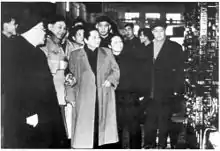
Soong's public appearances were limited after the Cultural Revolution, and she was in generally poor health, but articles by her, primarily on children's welfare issues, continued to appear in the press. Her last public appearance was on 8 May 1981, when she appeared in a wheelchair at the Great Hall of the People to accept an honorary LL.D. degree from the University of Victoria. A few days later she began running a high fever and was unable to rise again. On 16 May 1981, less than two weeks before her death, she was admitted to the Communist Party and named Honorary Chairwoman of the People's Republic of China (中华人民共和国名誉主席). She is the only person to ever hold this title.[14] According to one of Soong's biographers, she had wanted to join the Communist Party of China as early as 1957. However, when she asked Liu for permission to join the party, the request was turned down because "it was thought better for the revolution that she not join formally, but that she would thenceforth be informed, and her opinion sought, concerning all important inner-Party events matters, not only those involving the government."[15]
Museums
According to her wishes, Soong's cremated remains was placed next to her parents' restored grave in the Soong family burial plot at Shanghai's International Cemetery (Chinese: 万國公墓),[16] which was later renamed in her honor as the Soong Ching-ling Memorial Park (Chinese: 宋庆龄陵园).
Several of Soong Ching-ling's former residences have also been transformed into museums:
In 1918, Soong and her husband Sun Yat-sen lived in a house in the French Concession of Shanghai. After her husband's death, Soong continued to reside there until 1937. The house has now been converted into a museum dedicated called the Former Residence of Sun Yat-sen. Though dedicated primarily to Sun, it also contains some of Soong's artefacts during their life together.
From 1948 to 1963 Soong Ching-ling lived in the western end of the French Concession in Shanghai. This building is now the Soong Ching-ling Memorial Residence. A memorial hall containing some of her belongings and photographs stands near the entrance. The main building and gardens are preserved in near original state with original furnishings throughout. In the garage are two large cars: one Chinese built Red Flag limousine and another "Russian" car presented to Soong by Josef Stalin.
Soong Ching-ling obtained a mansion in Beijing in 1963 where she lived and worked for the rest of her life and received many dignitaries. After her death the site was converted into the Former Residence of Soong Ching-ling as a museum and memorial. The rooms and furniture have been kept as she had used them, and memorabilia are displayed.
Media portrayal
In the 1997 Hong Kong movie The Soong Sisters, she is portrayed by Maggie Cheung.
In the 2009 mainland China movie The Founding of a Republic, she is portrayed by Xu Qing.
Family
Notes
- Before the 1982 Constitution President of the People's Republic of China was officially translated as "Chairman" by the PRC government.
References
Citations
- Epstein 1993, p. 551.
- Leaders of China (People's Republic of China), zarate.eu from 11 May 2017, retrieved 12 July 2017.
- 宋庆龄上海出生地解谜
- 宋庆龄出生地在川沙
- Hahn 1941, pp. 43–45.
- Dosti, Rose (3 November 1994). "KITCHEN MATRIARCHS : The Unsinkable Madame Wu". Los Angeles Times.
- Epstein 1993, p. 437.
- Song Qingling at Encyclopædia Britannica
- "Mme. Sun Yat-Sen Ordered Arrested". Los Angeles Times. 9 October 1949.
- Klein & Clark 1971, p. 785.
- Klein & Clark 1971, p. 786.
- Epstein 1993, p. 550.
- Sheng, Yonghua. 《宋庆龄年表》[A Chronology of Song Qingling]. Guangdong People's Press, 2006, 2: 601.
- Epstein 1993, pp. 616–617.
- Epstein 1993, p. 491.
- Avelihiihine-Dubach, Natacha. "The Revival of the Funeral Industry in Shanghai: A Model for China" in Invisible Population: The Place of the Dead in East-Asian Megacities, pp. 79–80. Lexington Books (Lanham), 2012.
Sources
- Chang, Jung; Halliday, Jon (1986). Madame Sun Yat-Sen: Soong Ching-Ling. London, England: Penguin. ISBN 0-14-008455-X.CS1 maint: ref=harv (link)
- Epstein, Israel (1993). Woman in World History: The Life and Times of Soong Ching-ling. Beijing: China Intercontinental Press. ISBN 7-80005-161-7.CS1 maint: ref=harv (link)
- Hahn, Emily (1941). The Soong Sisters. New York, NY: Doubleday, Doran & Co.CS1 maint: ref=harv (link)
- Klein, Donald W.; Clark, Anne B. (1971). Biographic Dictionary of Chinese Communism, 1921–1965. 2. Cambridge, MA: Harvard University Press. ISBN 0-552-14108-9.CS1 maint: ref=harv (link)
- Seagrave, Sterling (1996). The Soong Dynasty. London, England: Corgi Books. ISBN 0-552-14108-9.CS1 maint: ref=harv (link)
External links
| Wikimedia Commons has media related to Soong Ching-ling. |
See also
- History of the Republic of China
- Revolutionary Committee of the Chinese Kuomintang
- He Xiangning (wife of Liao Zhongkai)
- Soong sisters
- Soong Ching-ling Children's Literature Prize
| Government offices | ||
|---|---|---|
| New office | Vice Chairperson of the Central People's Government 1949–1954 Served alongside: Zhu De, Liu Shaoqi, Li Jishen, Zhang Lan, Gao Gang |
Succeeded by Zhu De as Vice Chairman of the PRC |
| Preceded by Zhu De |
Vice Chairperson of the People's Republic of China 1959–1975 Served alongside: Dong Biwu |
Vacant Title next held by Ulanhu |
| Preceded by Liu Shaoqi as Chairman of the PRC |
Acting Head of State of the People's Republic of China Co-Acting with Dong Biwuas Vice Chairpersons of the PRC 1968–1972 |
Succeeded by Dong Biwu as Acting Chairman of the PRC |
| Preceded by Zhu De as Chairman of the 4th NPCSC |
Acting Head of State of the People's Republic of China As acting Chairwoman of the Standing Committee of the 4th National People's Congress 1976–1978 |
Succeeded by Ye Jianying as Chairman of the 5th NPCSC |
| Honorary titles | ||
| New title | Honorary Chair of the All-China Women's Federation 1949–1981 Served alongside: He Xiangning, Cai Chang, Deng Yingchao |
Succeeded by Kang Keqing |
| Honorary President of the People's Republic of China 1981 |
Vacant | |

